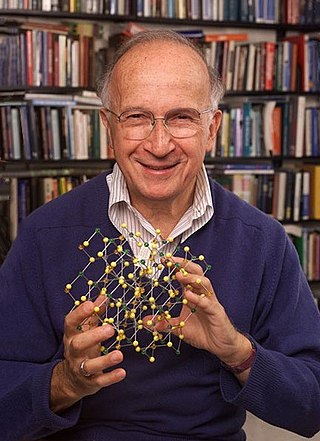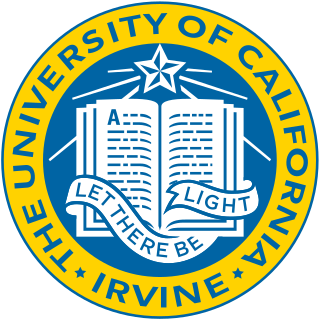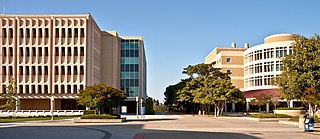Related Research Articles

Roald Hoffmann is a Polish-American theoretical chemist who won the 1981 Nobel Prize in Chemistry. He has also published plays and poetry. He is the Frank H. T. Rhodes Professor of Humane Letters Emeritus at Cornell University.

Linus Carl Pauling was an American chemist, biochemist, chemical engineer, peace activist, author, and educator. He published more than 1,200 papers and books, of which about 850 dealt with scientific topics. New Scientist called him one of the 20 greatest scientists of all time. For his scientific work, Pauling was awarded the Nobel Prize in Chemistry in 1954. For his peace activism, he was awarded the Nobel Peace Prize in 1962. He is one of five people to have won more than one Nobel Prize. Of these, he is the only person to have been awarded two unshared Nobel Prizes, and one of two people to be awarded Nobel Prizes in different fields, the other being Marie Curie.

The University of California, Irvine is a public land-grant research university in Irvine, California. One of the ten campuses of the University of California system, UCI offers 87 undergraduate degrees and 129 graduate and professional degrees, and roughly 30,000 undergraduates and 6,000 graduate students were enrolled at UCI as of Fall 2019. The university is classified among "R1: Doctoral Universities – Very high research activity" and had $523.7 million in research and development expenditures in 2021. UCI became a member of the Association of American Universities in 1996.

Rudolph Arthur Marcus is a Canadian-born American chemist who received the 1992 Nobel Prize in Chemistry "for his contributions to the theory of electron transfer reactions in chemical systems". Marcus theory, named after him, provides a thermodynamic and kinetic framework for describing one electron outer-sphere electron transfer. He is a professor at Caltech, Nanyang Technological University, Singapore and a member of the International Academy of Quantum Molecular Science.

Frank Sherwood "Sherry" Rowland was an American Nobel laureate and a professor of chemistry at the University of California, Irvine. His research was on atmospheric chemistry and chemical kinetics. His best-known work was the discovery that chlorofluorocarbons contribute to ozone depletion.

Carolyn Ruth Bertozzi is an American chemist and Nobel laureate, known for her wide-ranging work spanning both chemistry and biology. She coined the term "bioorthogonal chemistry" for chemical reactions compatible with living systems. Her recent efforts include synthesis of chemical tools to study cell surface sugars called glycans and how they affect diseases such as cancer, inflammation, and viral infections like COVID-19. At Stanford University, she holds the Anne T. and Robert M. Bass Professorship in the School of Humanities and Sciences. Bertozzi is also an Investigator at the Howard Hughes Medical Institute (HHMI) and is the former director of the Molecular Foundry, a nanoscience research center at Lawrence Berkeley National Laboratory.

Sir David William Cross MacMillan is a Scottish chemist and the James S. McDonnell Distinguished University Professor of Chemistry at Princeton University, where he was also the chair of the Department of Chemistry from 2010 to 2015. He shared the 2021 Nobel Prize in Chemistry with Benjamin List "for the development of asymmetric organocatalysis". MacMillan used his share of the $1.14 million prize to establish the May and Billy MacMillan Foundation.
The University of California, Irvine has over fourteen academic divisions.

The School of Physical Sciences is an academic unit of the University of California, Irvine (UCI) that conducts academic research and teaching in the field of physical sciences. It offers both pre-professional training and general education in the departments of chemistry, earth system science, mathematics, and physics and astronomy. The school enrolls 1,400 undergraduate and graduate students and is one of the top schools in the nation in the number of degrees it confers in the area of physical sciences. It also offers specializations such as biochemistry, statistics, math for economics, applied and computational mathematics, astrophysics, applied physics, biomedical physics, and education. In 1995, the school gained international prominence when Frank Sherwood Rowland, a professor in chemistry and Frederick Reines, a professor in physics, won the Nobel Prize in their respective fields. It was the first time two people won the prize in the same year in two different fields at the same public university.
Arthur S. Nowick was an American materials scientist. He made pioneering contributions to the study of internal friction, anelasticity, crystal defects and other subjects over a fifty-year career and helped develop materials science from a field focused on metals to one that encompasses all classes of materials.
Out to Innovate, previously known as the National Organization of Gay and Lesbian Scientists and Technical Professionals (NOGLSTP), is a professional society for professionals in science, technology, mathematics, and engineering. Each year, Out to Innovate gives the Walt Westman Award to members who helped make significant contributions to the association's mission.
Barbara J. Finlayson-Pitts is a Canadian-American atmospheric chemist. She is a professor in the chemistry department at the University of California, Irvine and is the Director of AirUCI Institute. Finlayson-Pitts and James N. Pitts, Jr. are the authors of Chemistry of the Upper and Lower Atmosphere: Theory, Experiments, and Applications (1999). She has been a member of the National Academy of Sciences since 2006 and is the laureate for the 2017 Garvan–Olin Medal. In 2016 she co-chaired the National Academy of Science report "The Future of Atmospheric Chemistry Research"
Dr. Virginia Uribe was an American educator, counselor and LGBT youth education outreach advocate. She was best known for founding the Los Angeles Unified School District's Project 10 program, an educational support and drop-out prevention program for LGBT youth, and the nonprofit arm of the Project 10 program, Friends of Project 10 Inc.

LGBT people in science are students, professionals, hobbyists, and anyone else who is LGBT and interested in science. The sexuality of many people in science remains up for debate by historians, largely due to the unaccepting cultures in which many of these people lived. For the most part, we do not know for certain how people in the past would have labelled their sexuality or gender because many individuals lived radically different private lives outside of the accepted gender and sexual norms of their time. One such example of a historical person in science that was arguably part of the LGBT community is Leonardo da Vinci, whose sexuality was later the subject of Sigmund Freud's study.
Suzanne A. Blum is an American professor of chemistry at the University of California, Irvine. Blum works on mechanistic chemistry, most recently focusing on borylation reactions and the development of single-molecule and single-particle fluorescence microscopy to study organic chemistry and catalysis. She received the American Chemical Society's Arthur C. Cope Scholar Award in 2023.

Vy Maria Dong is a Vietnamese-American Chancellor's Professor of Chemistry at the University of California, Irvine (UCI). Dong works on enantioselective catalysis and natural product synthesis. She received the Royal Society of Chemistry's Merck, Sharp & Dohme Award in 2020, the American Chemical Society's Elias James Corey Award in 2019, and the UCI's Distinguished Alumni Award in 2018.

Jennifer Margaret Heemstra is a Professor of Chemistry at Washington University in St. Louis. Her research makes use of the ability of nucleic acids to self-assemble and recognise other molecules. Alongside her research, Heemstra is a science communicator and writes a regular column for Chemical & Engineering News.

Zuzanna Stefania Siwy is a Polish–American chemist at the University of California, Irvine. Her research considers synthetic nanopores and their application in ionic devices. She is a Fellow of the American Physical Society, American Association for the Advancement of Science and Foundation for Polish Science.
Jennifer Ann Prescher is an American chemist who is a professor of chemistry at the University of California, Irvine. Her research considers the development of bioorthogonal, bioluminescent tools for the noninvasive, real-time imaging of immunometabolism. She was recognized with the 2023 American Chemical Society Arthur C. Cope Scholar Award.
Kieron Burke is a professor known for his work in the field of quantum mechanics, particularly in developing and advancing density functional theory (DFT). He holds joint appointments as a distinguished professor in the Departments of Chemistry and Physics at the University of California, Irvine (UCI).
References
- 1 2 3 4 5 "James S. Nowick". University of California, Irvine. Retrieved 9 June 2015.
- 1 2 Wilson, Janet (11 March 2013). "Online chemistry lectures find worldwide audience". University of California News. Retrieved 9 June 2015.
- ↑ "Nowick, Gingiss, and Uribe to Receive 2009 NOGLSTP GLBT Awards Recognizing Their Contributions to the Fields of Science and Technology". NOGLSTP. 1 February 2009. Retrieved 9 June 2015.
- ↑ Columbia College (Columbia University). Office of Alumni Affairs and Development; Columbia College (Columbia University) (1987). Columbia College today. Columbia University Libraries. New York, N.Y. : Columbia College, Office of Alumni Affairs and Development.
- ↑ Nowick, JS (October 2008). "Exploring beta-sheet structure and interactions with chemical model systems". Accounts of Chemical Research. 41 (10): 1319–30. doi:10.1021/ar800064f. PMC 2728010 . PMID 18798654.
- ↑ Nowick, James S.; Smith, Eric M.; Pairish, Mason (1996). "Artificial ?-sheets". Chemical Society Reviews. 25 (6): 401. doi:10.1039/CS9962500401.
- ↑ "Arthur C. Cope Scholar Awards". American Chemical Society. Archived from the original on 9 June 2015. Retrieved 10 June 2015.
- ↑ Nowick, James S.; Brisbois, Ronald G. (August 1989). "The MIT Chemistry Outreach Program: Graduate students presenting chemistry to high school students". Journal of Chemical Education. 66 (8): 668. Bibcode:1989JChEd..66..668N. doi:10.1021/ed066p668.
- ↑ Yfke, Hager (August 2010). "The insider: Chemical outreach". Chemistry World. Royal Society of Chemistry. Retrieved 9 June 2015.
- ↑ "OpenChemistry Lecture Videos". UCIrvine. Retrieved 9 June 2015.
- ↑ "UC Irvine Receives Accolade for its Open Chemistry Project". PRnewswire (Press release). Retrieved 9 June 2015.
- ↑ Wang, Linda (23 May 2011). "Paving The Way: Finding Mentors And Role Models". Chemical & Engineering News. American Chemical Society. Retrieved 10 June 2015.
- ↑ Chen, Mengfei (17 February 2009). "How Constitutional is Proposition 8?". New University: Official Campus Newspaper. University of California, Irvine. Retrieved 10 June 2015.
- ↑ "Gay and Transgender Chemists and Allies Subdivision". American Chemical Society. Retrieved 10 June 2015.
- ↑ Coley, Ian (20 August 2013). "Empowering LGBT Scientists". Medill Equal Media Project. Archived from the original on 11 June 2015. Retrieved 10 June 2015.